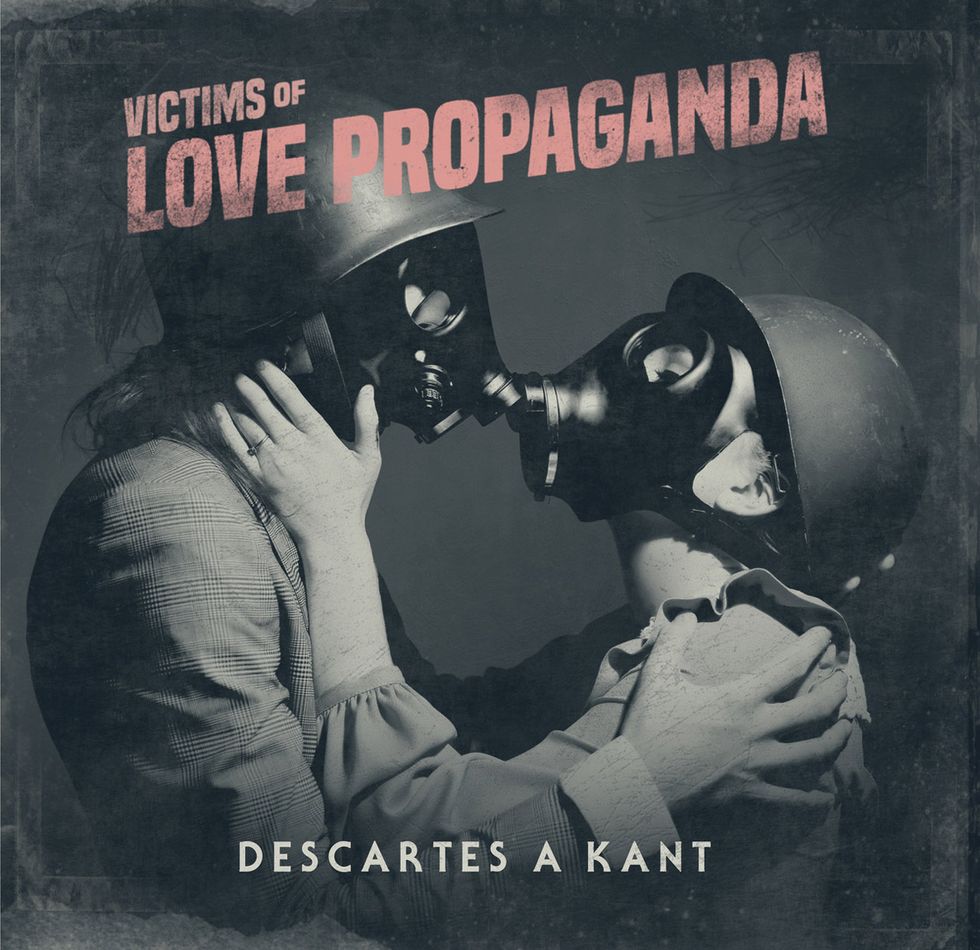The avant-garde Mexican rockers employ all genres and a giddy love for effects to express haphazard riffs, and above all, maintain a value for melody and a message.
Descartes a Kant’s Victims of Love Propaganda greets you with a pitch-shifted voice straight out of a nightmare, coughing and announcing, “Now, let’s take a moment to discuss the current theories about the biological basis of looooove...”
Next thing you know, you’re being pounded over the head by the opening riff of a song called “You Assfucked My Heart.” Acting as the album’s overture, the distortion-soaked track cycles through a series of tight breaks, tense riffs, and a searing saxophone solo, never settling long enough to catch a breath.
The songs that follow scream with the impulsive intensity of avant-garde bands like Mr. Bungle, Secret Chiefs 3, and Naked City. While shock and awe leads the way in the Guadalajara, Mexico-based band’s music, it isn’t all Descartes a Kant is about.
When Descartes hits the stage, the mayhem really gets unleashed. Guitarist/vocalists Sandrushka Petrova and Dafne Macías lead the group with frenetic energy, performing unison moves amidst flashing emergency lights, surrounded by the rest of the band members in hazmat suits. Their high-powered live show and deep embrace of varied sounds has helped Descartes a Kant secure gigs around the world with a diverse set of heroes, such as Sonic Youth, the Yeah Yeah Yeahs, Slayer, and Dave Lombardo’s Dead Cross.
While Victims of Love Propaganda is Descartes a Kant’s third studio album, it’s the band’s debut release in America. This time around, they worked with legendary engineer and producer Steve Albini (Nirvana, Pixies, Jesus Lizard) at his Electrical Audio studios in Chicago. Albini’s analog recording approach helped give Victims of Love Propaganda a direct, in-your-face sound that serves to make the record sonically explosive.
Premier Guitar sat down with Petrova and Macías to discuss their relationship-focused concept album, calculated songwriting approach, and elaborate live shows. While the band is obviously detail oriented, they keep their eyes on the big picture—unconcerned with obsessing over gear, instead considering how to get the most effective songs to deliver what they want to say.
—Sandra Petrova
How did the band form and how long have you been together?
Sandra Petrova: I started this band in a non-pretentious way, not knowing it was going to be like a serious relationship. It started in the bedroom in 2001 in Guadalajara. In 2005, Androv the keyboard player, Dafne, and our previous drummer joined and we released our first album in 2007. To me, that’s when the band started in a serious form and we’ve been working ever since, like a functional/dysfunctional family. In 2010, Christy [Ana Cristina Mo], Mo [Memo Ibarra], and the drummer [Jorge Chavez] joined.
Let's talk about the band’s name. It’s two philosophers, Rene Descartes and Immanuel Kant.
Petrova: Basically, it’s like an analogy to this confluence of postures and ideological philosophy shit that is much like what happens with our sound. If you see genres like ideas, they all come together in this unique, alien, punk music that includes lots and lots of musical forms. Although they’re opposite, it doesn’t matter.
What kind of scene did the band develop in? Were you playing with mostly heavier bands?
Petrova: It was a local scene [in Guadalajara, Mexico]. We’re a band that plays with any kind of band. I think we’ve never felt like we belonged to a scene. That makes possibilities huge, to try to live with all this music that is happening in our country, so we can play one day with a ska band or…. what’s the craziest?

Tidbit: Descartes a Kant recorded its U.S. debut, Victims of Love Propaganda, using an analog approach with legendary producer/engineer Steve Albini at his Electrical Audio studio in Chicago. Before entering the studio, the band mapped out an ideal guitar sound and assembled a new pedalboard from scratch specifically for the album.
Dafne Macías: Like a salsa band, mariachi....
Petrova: Mariachi in Russia! That sounds very weird. But, I think that that’s the cool part of this: like we don’t belong to one thing, but to everyone and everything.
Your songs tread a lot of ground and seem to draw on a wide variety of material. A song like, “You Assfucked My Heart,” the first track on Victims of Love Propaganda, is based on heavy riffs, extreme vocals, and has a screaming John Zorn-style sax solo—it’s brutal! But then “Motion Picture Dreamboy” is almost like a ’60s girl-band song. How do you pull together such wide influences?
Petrova: Yeah, as you said, the influences are very diverse. I see it almost as like a polyamorous relationship with music. And everything fits. It wasn’t this conscious process like, “Oh, I want to sound so weird and crazy and just put all this together like a collage.” But it was like, “What if we kind of fuck around with structure and we put all this stuff together and maybe it makes sense or maybe we can stop making sense.” Obviously, Mr. Bungle is a direct influence and I think every member of this band has a love for [Mr. Bungle vocalist] Mike Patton projects.
A band like this is not a jamming kind of band. It’s not just like a huge accident that happens; it does have layers. I write a lot of the songs, but also this record was very collaborative because some songs or parts of them were written by the bass player, some lyrics were written with my brother and a friend of mine who is a psychiatrist, and then some arrangements, vocal arrangements, were written by Dafne. So, I think we came to this point to learn how to work together with an idea that probably I incept.
The trio of females on guitar in Descartes a Kant are a far cry from traditional performers. They’re constantly passing the guitar around onstage, each taking turns on riff duties. From left to right: Ana Cristina Mo, Sandra Petrova, and Dafne Macías. “It’s kind of complex,” says Petrova. Photo by Andy McCormick
How does the songwriting process work for you?
Petrova: It’s a very intimate process to me. Songwriting is not jammy—it’s not coincidence. I'm not a jamming person at all. I calculate everything. But music comes after what you want to say. I think I trust a lot in the melody. Everything starts from the melody, which is the center element to me. I think this is the record where harmony has more protagonism. It’s more elaborated than in the other records. It’s more like a songwriter thing. You can play these songs with a guitar and vocals or piano and vocals and I think that wasn’t something that happened easily in the other records.
I don’t wanna sound like or say it or admit, but I’m a control freak. I have to write everything and see that it’s perfect before I show it to someone.
Does that leave a lot of room for you to create your parts, Dafne? How do you approach playing new songs when Sandra brings them to you?
Macías: Sandra’s work is very diverse. Sometimes compositions are so structured that there’s no space to include my own part. The mission then becomes to achieve the necessary sound and interpretation so the composition sounds as it’s intended. Some other occasions, like for example, in “Lovely Lips,” Sandra would send a demo that, although it’s pretty clear, it does have some room. The ideas I develop are within the context of the musical discourse previously established, and the goal is to enrich this idea and achieve its maximum potential.
I’m curious about your guitar influences.
Petrova: In my case, for most of my life I was a very anti-solo person. I’m drawn to guitar playing that’s kind of fucked up and weird. I can say that one of my recent influences is Annie Clark and her way to just create this beautiful language with her guitar and her riffs and her fuzz pedals. Also [Sonic Youth guitarists] Thurston [Moore] and Lee Ranaldo. I think they marked us in very specific ways.
Macías: Sonic Youth, Pixies, Pavement—that kind of sound was very important to me when I was young. Now there are a lot of feminine figures making interesting stuff with guitar, like a very particular sound. Annie Clark is one of them of course, and Kim Gordon [of Sonic Youth]. Even though she played bass for most of her career, now she's playing guitar in what I think is a very interesting way, through feminine eyes.
You recorded this album with legendary engineer Steve Albini at his studio, Electrical Audio. He’s worked with a lot of your influences: Has it been a long-term goal of yours to work with Albini?
Petrova: I think we never imagined ... when we were on the plane heading to Chicago, I was thinking [Nirvana’s] In Utero was my first album I paid for and that if someone told the young me that someday I was gonna be recording with that producer, I wouldn’t believe it. We didn’t even think that we would record out of Mexico.
How did it come about for the band to record at Electrical Audio?
Petrova: It just came out of nowhere because we started working with this New York manager. He’s someone who wants to help the band and he suggested it would be cool if we started work here in the States, and suggested someone like Steve Albini would be cool. I was like, “Haha, yeah, it would be cool.” The idea kept moving until it materialized.
Sandra Petrova’s Gear
GuitarsFender Jaguar
Fender Mustang
Amps
Fender Twin Reverb
Effects
Eventide PitchFactor
Death By Audio Apocalypse
DigiTech Whammy
Electro-Harmonix MicroSynth
Fender Runaway Feedback Pedal
Strings and Picks
Raven Picks .60 mm
Fender .009–.042 gauge strings
Dafne Macías’ Gear
GuitarsFender Squier Jagmaster
Fender Jazzmaster
Amps
Roland Jazz Chorus
Effects
Eventide H9 Max
Eventide PitchFactor
DigiTech Whammy
Electro-Harmonix MicroSynth
Boss OD-20 Drive Zone
Dwarfcraft Devices Eau Claire Thunder
Boss NS-2 Noise Suppressor
Strings and Picks
Raven Picks .80 mm
Fender .010–.046 gauge strings
Was the result everything you hoped for?
Petrova: It was a mind-blowing experience for all of us that marked us in so many ways and made us learn and made us more capable and focused. Recording on analog is something we’d never done before and it’s way different in a time when we’re so used to the undo process! And undo and undo and let’s make another take and open millions of tracks and it’s very easy. We were thinking, “Hey, this is how old-school bands made records.” You have to play the whole way and the whole take and do your better take. You can’t waste your studio time or the tape.
The sound of the record is huge! There are lots of really crazy guitar tones and wild effects. What was your setup like?
Petrova: Something interesting to this record is that the sound of the guitars was worked out before going to the studio with Steve Albini. We were trying to find that every element in the songs sounded like it was going to be recorded. We just got this new gear and we formed a new pedalboard from scratch and we started to search for this ideal guitar sound. To me this is the best guitar sound that we’ve ever made, and it’s like that live so it’s super cool.
I have a very Eventide-phased sound. I think Eventide is essential for the songs coming out the way they came. It’s a very helpful, fun, crazy tool. For fuzz, I have an Apocalypse from Death By Audio, a [DigiTech] Whammy, and the [Electro-Harmonix] MicroSynth. We like that synthetic guitar sound. Crazy, but it seems like sometimes we don’t want a guitar to sound like a guitar in a traditional way. I have a very weird pedal that doesn’t exist anymore. It’s from Fender; it’s called the Runaway, and it’s a feedback pedal but the feedback is so beautiful. It’s very fun. It has this octave up or octave down or a fifth up, so I just use it in the song “Suppertime Rules,” but it’s totally worth it.
Macías: I have kind of the same gear Sandra has, because it was a mission to accomplish the sound of the way she recorded the demos. I have an Eventide, a Whammy, I have a fuzz from Dwarfcraft Devices, an [Electro-Harmonix] MicroSynth, an [Eventide] PitchFactor, which I love, and a distortion pedal from Boss. I have a noise gate also because it’s very difficult to control all the feedback stuff.
Petrova: Because in this band, silence is very important. It’s like it has the same importance as sound, so we have to shift from very noisy to silence—so we need this kind of noise gate to silence everything.
Descartes a Kant’s principal songwriter, Sandra Petrova, gets serious on a Fender Mustang during a performance at Guadalajara, Mexico’s Teatro Diana in April 2017. Petrova prefers this model for all her guitar work, from writing songs to playing live. Photo by Charles Pinet
What about guitars and amps?
Petrova: Fender, 100 percent. This album was written and recorded with the same guitar. Albini had a lot of guitars but we were like, “No, let’s take our guitars.” I prefer using a Twin Reverb live and in the studio.
A Mustang seems to be my favorite right now. I have a Stratocaster and a Telecaster that are just asleep in the rehearsal room waiting for me to visit. The Mustang has this quality I got very used to when I was writing the songs, so I wanted the exact same sound. But, also anatomically speaking, it’s very light, so in our live performance that’s a very important factor because it allows me to have more movement onstage and to not feel like I’m carrying this super heavy thing.
Macías: Like a Stratocaster!
Petrova: Yeah, because, you know, it’s very theatrical and it’s very active and we’re like maniacs onstage, so when I tried the Mustang it was like, “Whoa, this is my guitar. This allows me to be my better live version.” So, it’s important.
I’m not very specific. I’m not a guitar nerd at all. Someone was asking me the other day about stuff I don’t believe I need to make songs. I could write my songs with any guitar, I just prefer these. When we use Marshalls, it’s like, we can’t do that. It’s like kissing someone and you don’t know what’s wrong but you know something’s wrong. So my approach to music is far from gear-ish and it’s far from technical.
Macías: I use the Jagmaster. I love that sound—I love it! I think it has the best of the two worlds. It can accomplish a very clean and round sound, but also it can be very loud and have a very good response to distortion. So, I love Jagmaster. I want to marry one!
I have a Jazz Chorus from Roland. I prefer to use Fender, but I don’t have one. I’m poor! But I like the sound of that amp because it’s the same idea as a Jagmaster: It responds to a very clean sound but functions very well with distortion.
You’re both running around onstage a lot of the time. Do you consider the theatrical production while you’re writing and recording and deciding on your guitar parts, or does that come after you’re finished with the music?
Petrova: Sometimes, before music or before arrangements, there’s this idea of, “What we can do live?” We admire a lot of artists, like David Byrne or Laurie Anderson, that can maintain this perfect balance between making this amazing weird show but also music that is impeccable.
Writing the songs, you can see and visualize, “This has to have this performance,” so it doesn’t matter who plays the guitar. It’s not like, “I’m the guitar player, I have to play all the songs,” so that’s when Christy
is very important in the equation, because she plays the riffs and we can express more actively what the song wants to say. Live we are changing guitars and just taking them on and off and passing them to Christy and Christy sometimes plays my guitar or Dafne’s guitar. It’s kind of complex.
Victims of Love Propaganda is a concept album that you call “emotional porn.” Can you expand on that a little?
Petrova: It talks about the way we live relationships and how our society has influenced the way we go through these relationships. “Until the Day We Die” is a very direct and emotional lyric that in four verses describes how a marriage or a long-term relationship can go fading out to the point that you just feel psychotic and questioning a lot of things in these rules of being in a couple and how sometimes if you pay attention, you will see this manipulation and wanting to control the other person. Ego is very involved in our decisions and the things that affect us as human beings in these relationships, so it does talk about romantic projections and this idea of wanting to be with someone ’til the day you die. Is that absolutely necessary? Is that something beyond our control, something we’re programmed with? So that’s one example of how the songs open these conversations. But it’s not pretending to be a conclusive work, because the subject is so complex and there are a lot of layers to talking about relationships and humans and the way we interact. So it’s kind of just having these questions and opening them to the world and showing the devastation behind it. It’s intense and it’s from a very female perspective.
“Crime Scene” is a song about the death of a relationship. It talks about how when you get out of a relationship, you’re like your own forensic team, researching. Whose fault is this? Who is responsible for being in this? And you just see this mayhem, and in a symbolic way, you just open your eyes and everything is blood, all over the place. And you’re looking at the injured people and you’re one of them, but also you’re like the victim and the victimizer and the perpetrator and everyone has their part and it’s your job to assume your part of the mess. When we perform it live, we all have these forensic suits and it’s someone waking up in the middle of a crime scene.
I think, that’s the album: The register that something happened and it was lived from a specific way and from very tricky perspectives but the big metaphor is an exercise to see and to evidence a relationship.
YouTube It
Petrova and Macías are in sync in their movement and guitar action in this live performance of “Crime Scene.” They make excellent use of space and dynamics to build tension between the quiet, arpeggiated figures and the giant riffs in the rock-out sections. Get a good sense of their tastes in heavily effected tones throughout and check out the twisted, pitch-shifted melody the pair of guitarists play together at 2:42.




